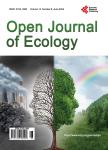Effects of micro-environmental conditions and forest disturbance on the establishment of two Andean palms in Ecuador
Effects of micro-environmental conditions and forest disturbance on the establishment of two Andean palms in Ecuador作者机构:Ecology and Genetics Pontificia Universidad Católica del Ecuador Quito Ecuador Forest & Landscape University of Copenhagen Copenhagen Denmark
出 版 物:《Open Journal of Ecology》 (生态学期刊(英文))
年 卷 期:2012年第2卷第4期
页 面:233-243页
学科分类:1002[医学-临床医学] 100214[医学-肿瘤学] 10[医学]
主 题:Andean Forest Ceroxylon Forest Disturbance Micro-Environmental Variables Palm Establishment Prestoea Sustainable Management
摘 要:The wax palm (Ceroxylon echinulatum) and palm heart (Prestoea acuminata) are key elements in Andean natural forests. This ecosystem is threatened by deforestation and habitat degradation, thus, it is vital to explore the impact of anthropogenic activities on the ecological structure and preferences of these species in order to develop proper conservation strategies. Fifty-seven 400 m2 plots were established in two forest areas, a disturbed forest (n = 30 plots) and an undisturbed forest (n = 27 plots) in the Ecuadorean Andes. Nine micro-environmental variables and the number of individuals of C. echinulatum and P. acuminata in five size classes were recorded in each plot. Logistic regression models helped identify environmental variables that influence the establishment of the species. Results showed that different micro-environmental variables determined the presence of different size classes. Both species were benefitted by the environmental conditions of the disturbed forest. Light availability was important for the establishment of both species, especially for the canopy species (C. echinulatum). This palm was negatively affected by the variable “fallen wood, while P. acuminata was negatively affected mainly by the steepness of the terrain. The environmental variables for the successful establishment of the studied species that were identified by this study provide clues for the sustainable management of C. echinulatum and P. acuminata in Andean forests.



